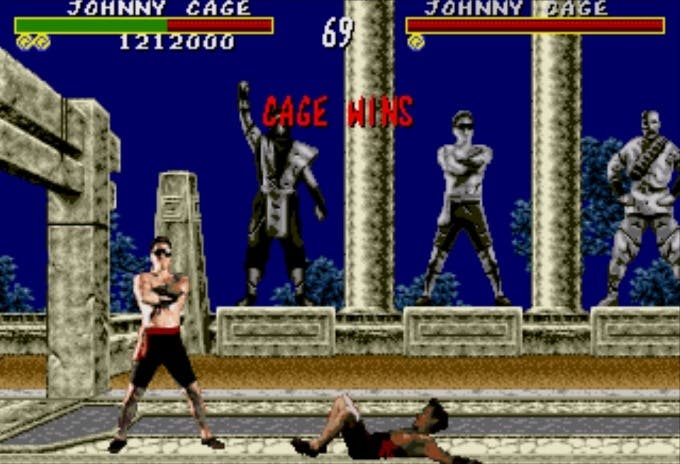Mortal Kombat: Blood and Money
A look back at Midway's infamous fighter.
We all loved Mortal Kombat. Sorry, let's start that again: we all played Mortal Kombat. Or saw some now-forgotten sports personality play it on GamesMaster while Dominik Diamond quipped away in the background. It was a '90s Mega Drive/Genesis sensation (or pleasant Amiga surprise, or disastrous Master System conversion, amongst others) with sales figures to match the hype. The sequel, Mortal Kombat II, shovelled USD 50 million into Acclaim's expanding pockets in the first week alone, ensuring the series featured on the business pages as well as beneath sensationalist headlines about ripping out spines.
Exciting stuff for the newsdesks, but even better for the schoolyards. The secondary and highschool pupils of 1993 (mostly of the male variety it's fair to say) didn't need to be studying Lord of the Flies to know that only the frail barriers of society were preventing them from tumbling into bloodlust. Lurid rumours of a game which let players fire a harpoon into an opponent's neck and drag him back across the screen were like throwing tasty t-bones to a pack of hungry pooches. Playground whispers went into overdrive, leading to a spate of children believing it was possible to finish off adversaries by pulling off their arms and slapping them about the head with the stumps while chanting 'stop hitting yourself, stop hitting yourself.' Inevitably, such violence (real or imagined) was was a major selling point to the hordes of merrily sadistic youngsters with disposable incomes.

His name's not Fatty, it's Piggy
A little overstated? Perhaps. But at the time of writing, putting "mortal kombat, fatality" into YouTube's search box brings up over 3,600 results. Try the same with "mortal kombat, game" and the number falls 100 short of that (back off man; I'm a scientist), and the first hit is a compilation of fatalities. Enough to suggest that, alongside people bashing out the theme on casio keyboards and comedy montages of the godawful film, fatality footage from the series dominates the cultural barometer. Admittedly, the SNES release of the original faired well despite being bereft of blood (instead featuring mysterious grey 'sweat' globules), yet it was also massively outsold by the SNES versions of Mortal Kombat II and III, which relented and restored the gore.
To assume the fatalities were so popular due to blood and guts alone, however, is to overlook what may have been Mortal Kombat's greatest fascination - that of unlocking its secrets. Even the red gloop itself had to first be switched on with a hidden code, giving the game an enigmatic, illicit feel, suggesting further concealed depths to be uncovered. The fatalities too could only be performed with an extended series of pad nudges and button presses, unlikely to be found through mere trial and error. This not only bathed them in the illusion of mystery, but also bestowed power and kudos on those who could claim to know their details. A lifetime's supply of letters to computer magazine tips pages was almost guaranteed, to the extent that certain publications started printing misinformation about the 'special way' you could 'be' Goro or just began to use it as a running gag. In an age before internet ubiquity, this was an excellent way to create a sense of shared community between Mortal Kombat's players, the game's designers and the various publications of the time. Although the mags were probably heartily sick of running double-page spreads explaining exactly how to punch Kano into a pit and discover Reptile.
Toward, Toward, Away, Away, Away, A

Mortal Kombat II confirmed that the makers were aware how strong the combination of blood and secret content had been. Rather than do anything in particular to the central game mechanics (aside from the odd cosmetic change), they instead increased the number of characters - thereby increasing the volume of fatalities to be discovered. They also tripled the finishing move potential by adding odd 'friendship' and 'babality' abilities to each character, as well as increasing the number of special moves available to the fighters from the previous game. It was a marketing triumph.
